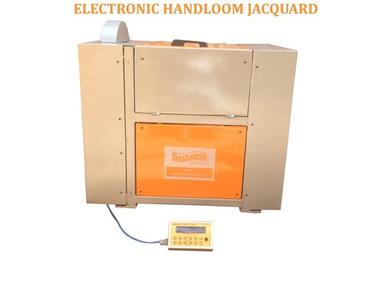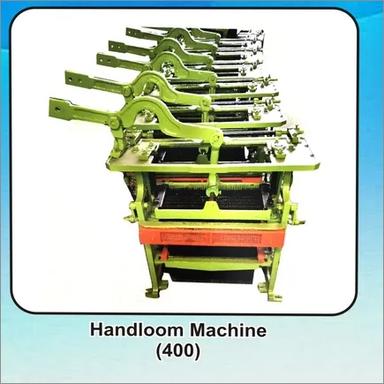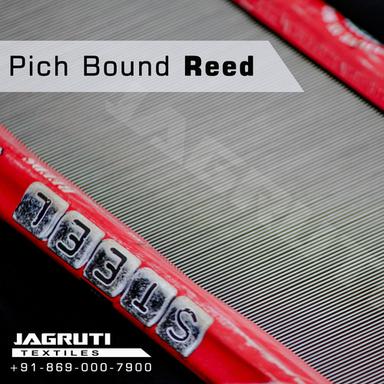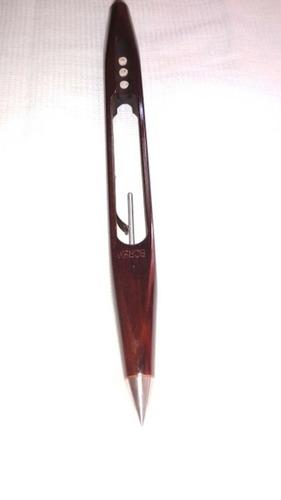Handloom Machine
(37 products)
Handloom Machine 400 Number hooks one side cylinder
Price: 14000 INR (Approx.)
MOQ - 1 Unit/Units
5 Years
Business Type: Manufacturer | Supplier
GURU KIRPA JACQUARD INDUSTRIES
Iron Semi Automatic Power Loom Machine
Price: 50000.00 - 250000.00 INR (Approx.)
MOQ - 1 Piece/Pieces
Product Type - Textile Machinery
Material - Iron
Voltage - 220-440 Volt (v)
6 Years
Business Type: Manufacturer | Distributor
KERU SUTEX MACHINE AND TEXTILES
Handloom Jacquard Machines Capacity: 20-50 Kg/Hr
Price: 2500 INR (Approx.)
MOQ - 1 Unit/Units
Material - Aluminium & Stainless Steel
Capacity - 20-50 Kg/hr
Voltage - 440 Volt (v)
13 Years
Business Type: Manufacturer | Exporter
DURGA ENGINEERING WORKS
Indian Inquiries Only
Skin Friendly Printed Floor Carpet
MOQ - 500 Square Foot/Square Foots
Feature - Quick Drying
Pattern - Printed
Shape - Rectangle
3 Years
Business Type: Manufacturer
JK Enterprises
Easy to Use Handloom Machine
Price: 1895 USD ($) (Approx.)
MOQ - 1 Pair/Pairs
Product Type - Other, Easy to Use Handloom Machine
Material - handloom
Machinery Type - Other
Business Type: Manufacturer | Exporter
SRI LAKSHMI NARAYAN EXPORTS INTERNATIONAL
Verified Exporter
( Accepts only Foreign Inquiry)
Black And Green Three Phase Army Webbing Belt Machine Inbuilt With 1 Hp Electric Break Motor
Price: 185000.00 INR (Approx.)
MOQ - 1 Set/Sets
Color - Black and Green
Product Type - Textile Machinery
Material - Metal
Business Type: Manufacturer | Supplier
VISHWAKARMA INDUSTRIES
Brown Sturdy Construction Industrial Handloom Machine
Price: 200000.00 - 500000.00 INR (Approx.)
MOQ - 1 Unit/Units
Product Type - Textile Machinery
Material - metal
Color - brown
Business Type: Manufacturer
Sachin Engineerng Works
Related Searches
Black Manual Grade Wire Mesh Handloom Machine
Price: 600000.00 INR (Approx.)
MOQ - 1 Piece/Pieces
Color - Black
Product Type - Garment Machinery
Material - Metal
Business Type: Manufacturer | Distributor
Surendra Wire Netting Machinery Works
2 Years
Business Type: Manufacturer
MUSA AGRO INDUSTRIES PVT LTD
4 Years
Business Type: Manufacturer
G.S.ENGINEERING TEXTILE
Business Type: Manufacturer | Exporter
ARVIND INDUSTRIES
Business Type: Manufacturer | Exporter
Parshwa Enterprise
Response Rate: 100.00%
Business Type: Manufacturer | Exporter
SWAMY DHONDUSA FABRIC
Verified Exporter
( Accepts only Foreign Inquiry)
Business Type: Distributor
Dolphin International
Business Type: Manufacturer
G S JACQUARD WORKS
Indian Inquiries Only
Business Type: Trading Company
Murli Trading Company
Business Type: Manufacturer
Weban Machinery
Importance of Handloom Machines in Handloom Industry
What is Handloom Industry?
Handloom industry comprises of the section of weaving community, that produces clothes or designs using a handloom. A handloom is a traditional weaving machine, that allows for single threads to be knotted and weaved into long yarns. India has had a great history of handlooms and the use of a traditional Charkha is option represented as a symbol of our struggle to gain independence. Generally, handloom industries are house hold-based industry, but its role in providing indirect or direct employment to the weaving community can never be discarded. India has forever been a home for a thriving handloom industry.
How Handloom Machine Work?
The processes of shedding, plucking, and battening are the three primary steps involved in weaving, and they are universal to all forms of weave. In the bottom of the pit where the weaver stands, there are two pedals or treadles that are used to operate the loom. Heddles are fastened to harnesses, which in turn are fastened to the pedals. The harnesses are hung above the warp, and the heddles are hung from the harnesses themselves. Heddles are loops of string that have a single thread from the weft flowing through them. Heddles are used in weaving. When the weaver presses down on a pedal, it causes the halter with the associated heddles to be raised, which in turn lifts the warp threads. Imagine that each individual thread that makes up the warp has a number assigned to it. The threads with even numbers on the warp are raised by either of the two pedals, while the threads with odd numbers on the warp are raised by the other pedal. Shedding is the process of applying pressure on a pedal to form a shed, which is a vertical area between lifted and unraised warp yarns. After the shed has been released, the weaver must next thread the weft through the space created there.
The weft thread is twisted on a quill, which is a form of spool, and is then inserted inside of a shuttle after being transported between the looms. The shuttle is a container made of wood that is pointed across both ends, much like the stern of a canoe, so that it may glide easily over the warp. At either end of the weft, there are two loosely-fitting tiny compartments into which the shuttle may be inserted. These containers have threads attached to them, and those strings are tied together in the centre of the loom to form the loom. The weaver may move the shuttle across the breadth of the warp and into the box on the other side by gripping the two strings and yanking toward the left or the right. The term for this activity is picking.
The next task is to ensure that the weft remains as taut as possible. Battening is the method used to accomplish this goal. Reed is the name of the instrument that is used to carry out the aforementioned motion. It resembles a comb to some extent. Reed is laid across the weft in a direction that is perpendicular to the direction of the warp. Additionally, it separates each individual thread of the warp. Following the completion of each plucking, the weaver will bring the reed closer to themselves. Battening guarantees that the weft, once it has been driven over the warp, is securely jammed up against the preceding weft thread. This, in turn, ensures that the fabric is durable and tightly woven at the end.
Difference Between Power loom and Handloom Machine
A form of loom that is worked manually rather than with the assistance of electric power is known as a handloom. A handloom may be used to weave fabric or designs onto cloth. What began as a machinery to furnish needs has evolved into a specialised instrument for the hand craftsman who specialises in providing art and luxury textiles. The expanding textile industry has generated a significant need for handloom weavers, who were instrumental in the development of most of the cotton industry throughout the 19th century. To weave fabric using a sort of loom that is mechanically propelled and may be operated by either a steam engine or electric power, there is something called a power loom. Power looms represent a significant departure from the traditional handlooms that were formerly used in the textile industry. Because they are mechanically propelled, they are at least 10 times more productive than their handloom equivalents, and as a result, they dominate a significant portion of the market for cloth. On the other hand, a power loom can only reproduce a limited selection of different designs and patterns.
Due to the fact that it is handwoven, a handloom will always have a rough and uneven surface, which contributes to its overall sense of ethnic allure. Handwoven cloth is characterised by the presence of knots and thread pulls close to the border. A fabric woven on a power-loom will have an even texture and be faultless, but it will not have the appeal of a fabric woven on a handloom even if it is woven with the same yarns.
The reverse side of anything woven on a handloom is an exact reproduction of the front, while the reverse side of something woven on a power loom will have a large number of loose threads or floats hanging from it since it is impossible to weave them in when using a power loom. To perform the test, one must thus flip the cloth over and examine the reverse side.
Handlooms offer a number of benefits over power looms. Craftspeople put forth a lot of effort to weave intricate details. A power loom just isn't capable of producing designs with the same degree of intricate detail or level of precision. Weaves that are manufactured on machines often do not follow these traditional patterns, nor do they have the same amount of detail as those that are woven by hand. The handloom is the sole tool that can be used to execute certain types of weaving methods.
Because of the specific pressure that is applied by power-looms, the fabric is made thinner. As a result, an article of clothing that is woven by hand from the same raw materials will be thicker and will have more body. The looser weaving of handlooms, which also gives them greater resilience allows air to move through them, giving them the ability to breathe, in contrast to the impression of being blocked off that you get when using power looms. When compared to power-looms, handlooms have a higher ability to recover from creases or wrinkles because of the uneven weft weaving that they use.
Handloom Machine Price List
| Product Name | Expected Price |
|---|---|
| Handloom Machine 400 Number hooks one side cylinder | 14000 |
| Industrial Handloom Machine (400) | 14000 |
| Manual Grade Wire Mesh Handloom Machine | 600000 |
| Three Phase Army Webbing Belt Machine Inbuilt With 1 Hp Electric Break Motor | 185000 |
| Handloom Jacquard Machines | 2500 |
This Data was Last Updated on 2024-04-18
Handloom Machine Manufacturers | Suppliers in India
| Company Name | Location | Member Since |
|---|---|---|
| Dashmesh Jacquard And Powerloom Pvt. Ltd. | Panipat, India | 14 Years |
| Durga Engineering Works | Panipat, India | 13 Years |
| Keru Sutex Machine And Textiles | Ahmedabad, India | 6 Years |
| Guru Kirpa Jacquard Industries | Panipat, India | 5 Years |
| G.s.engineering Textile | Panipat, India | 4 Years |
| Jk Enterprises | Panipat, India | 3 Years |
| Musa Agro Industries Pvt Ltd | North 24 Parganas, India | 2 Years |
FAQs Related to Handloom Machine
- Tradeindia
- Textile & Garment Machinery
- Handloom Machine



